stop start YAMAHA V1 2015 Owners Manual
[x] Cancel search | Manufacturer: YAMAHA, Model Year: 2015, Model line: V1, Model: YAMAHA V1 2015Pages: 94, PDF Size: 3.01 MB
Page 5 of 94

Table of contents
General and important labels ........... 1
Identification numbers .................... 1
Primary Identification (PRI-ID)
number............................................ 1
Craft Identification Number (CIN) ....... 1
Engine serial number.......................... 1
Manufactured date label .................... 2
Model information ........................... 2
Builder’s plate .................................... 2
Important labels .............................. 4
Warning labels.................................... 5
Other labels ........................................ 8
Safety information ........................... 10
Limitations on who may operate
the watercraft ............................. 10
Cruising limitations ........................ 11
Operation requirements ................ 12
Recommended equipment ........... 14
Hazard information........................ 15
Watercraft characteristics ............. 15
Wakeboarding and water-skiing ... 17
Safe boating rules ......................... 18
Enjoy your watercraft
responsibly ................................. 19
Description....................................... 20
Watercraft glossary ....................... 20
Location of main components ...... 21
Control function operation ............. 25
Watercraft control functions ......... 25
Engine stop switch .......................... 25
Engine shut-off switch .................... 25
Start switch ..................................... 25
Throttle lever .................................... 26
Steering system ............................... 26
Cooling water pilot outlet ................. 27
Water separator................................ 27
Watercraft operation ...................... 28
Watercraft operation functions ..... 28
Reverse system (V1 Sport) ............... 28
Instrument operation ...................... 29
Multifunction information
center ......................................... 29
Information display ........................... 29
Equipment operation ...................... 34
Equipment..................................... 34
Seat .................................................. 34
Handgrip........................................... 34
Reboarding step (V1 Sport) .............. 35
Bow eye............................................ 35
Stern eyes ........................................ 36
Cleat ................................................. 36
Storage compartments .................... 36
Fire extinguisher holder and cover ... 38
Operation and handling
requirements ................................... 40
Fuel requirements ......................... 40
Fuel................................................... 40
Engine oil requirements ................ 42
Engine oil .......................................... 42
Draining the bilge water ................ 43
Draining the bilge water on land....... 43
Draining the bilge water on water .... 44
Transporting on a trailer................ 45
First-time operation ........................ 46
Engine break-in............................. 46
Pre-operation checks ..................... 47
Pre-operation checklist .................... 47
Pre-operation check points .......... 49
Pre-launch checks ........................... 49
Post-launch checks.......................... 54
Operation ......................................... 56
Operating your watercraft ............. 56
Getting to know your watercraft....... 56
UF2P72E0.book Page 1 Tuesday, August 26, 2014 10:08 AM
Page 6 of 94

Table of contents
Learning to operate your
watercraft ...................................... 56
Riding position ................................. 57
Launching the watercraft ................. 57
Starting the engine on water ............ 57
Stopping the engine ......................... 58
Leaving the watercraft...................... 58
Operating the watercraft .................. 58
Turning the watercraft ...................... 59
Stopping the watercraft ................... 61
Operating the watercraft in reverse
(V1 Sport) ...................................... 61
Boarding the watercraft ................... 62
Starting off........................................ 65
Capsized watercraft ......................... 66
Beaching and docking the
watercraft ...................................... 67
Operating in weeded areas .............. 67
After removing the watercraft from
the water ....................................... 68
Care and storage............................. 69
Post-operation care ...................... 69
Flushing the cooling water
passages....................................... 69
Cleaning the watercraft .................... 70
Battery care ...................................... 70
Long-term storage ........................ 73
Cleaning ........................................... 73
Lubrication ....................................... 73
Rustproofing..................................... 74
Maintenance .................................... 75
Maintenance.................................. 75
Tool kit.............................................. 75
Periodic maintenance chart ............. 76
Engine oil and oil filter ...................... 77
Specifications .................................. 78
Specifications................................ 78
Trouble recovery ............................. 79
Troubleshooting ............................ 79
Troubleshooting chart ...................... 79
Emergency procedures ................ 82
Cleaning the jet intake and
impeller ......................................... 82
Jumping the battery ......................... 83
Replacing the fuses .......................... 83
Towing the watercraft....................... 85
Submerged watercraft ..................... 85
Index................................................. 86
UF2P72E0.book Page 2 Tuesday, August 26, 2014 10:08 AM
Page 29 of 94
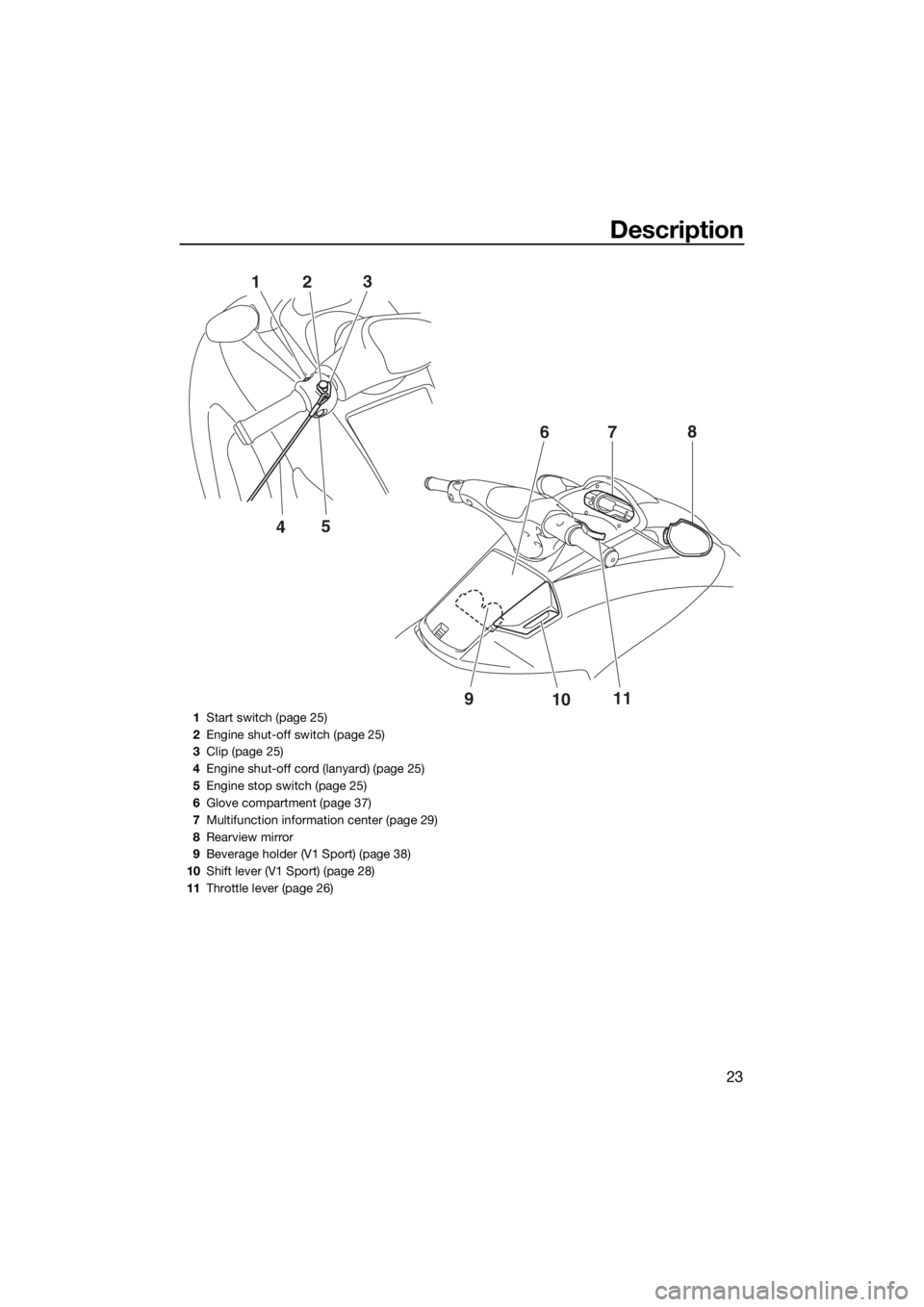
Description
23
5
4 1
23
9
1011 7
68
1Start switch (page 25)
2Engine shut-off switch (page 25)
3Clip (page 25)
4Engine shut-off cord (lanyard) (page 25)
5Engine stop switch (page 25)
6Glove compartment (page 37)
7Multifunction information center (page 29)
8Rearview mirror
9Beverage holder (V1 Sport) (page 38)
10Shift lever (V1 Sport) (page 28)
11Throttle lever (page 26)
UF2P72E0.book Page 23 Tuesday, August 26, 2014 10:08 AM
Page 31 of 94
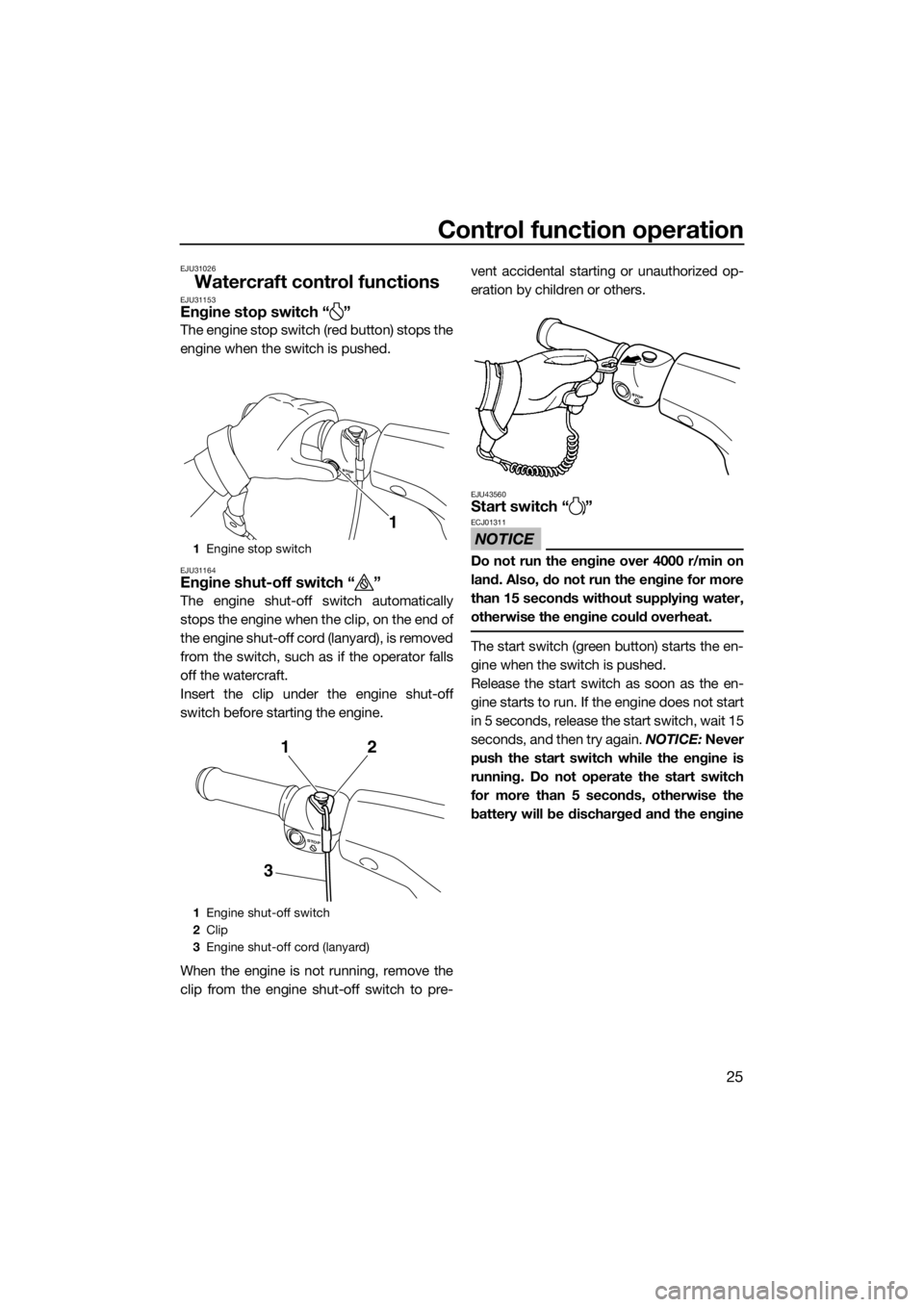
Control function operation
25
EJU31026
Watercraft control functionsEJU31153Engine stop switch “ ”
The engine stop switch (red button) stops the
engine when the switch is pushed.
EJU31164Engine shut-off switch “ ”
The engine shut-off switch automatically
stops the engine when the clip, on the end of
the engine shut-off cord (lanyard), is removed
from the switch, such as if the operator falls
off the watercraft.
Insert the clip under the engine shut-off
switch before starting the engine.
When the engine is not running, remove the
clip from the engine shut-off switch to pre-vent accidental starting or unauthorized op-
eration by children or others.
EJU43560Start switch “ ”
NOTICE
ECJ01311
Do not run the engine over 4000 r/min on
land. Also, do not run the engine for more
than 15 seconds without supplying water,
otherwise the engine could overheat.
The start switch (green button) starts the en-
gine when the switch is pushed.
Release the start switch as soon as the en-
gine starts to run. If the engine does not start
in 5 seconds, release the start switch, wait 15
seconds, and then try again. NOTICE: Never
push the start switch while the engine is
running. Do not operate the start switch
for more than 5 seconds, otherwise the
battery will be discharged and the engine
1Engine stop switch
1Engine shut-off switch
2Clip
3Engine shut-off cord (lanyard)
1
STOP
312
UF2P72E0.book Page 25 Tuesday, August 26, 2014 10:08 AM
Page 33 of 94
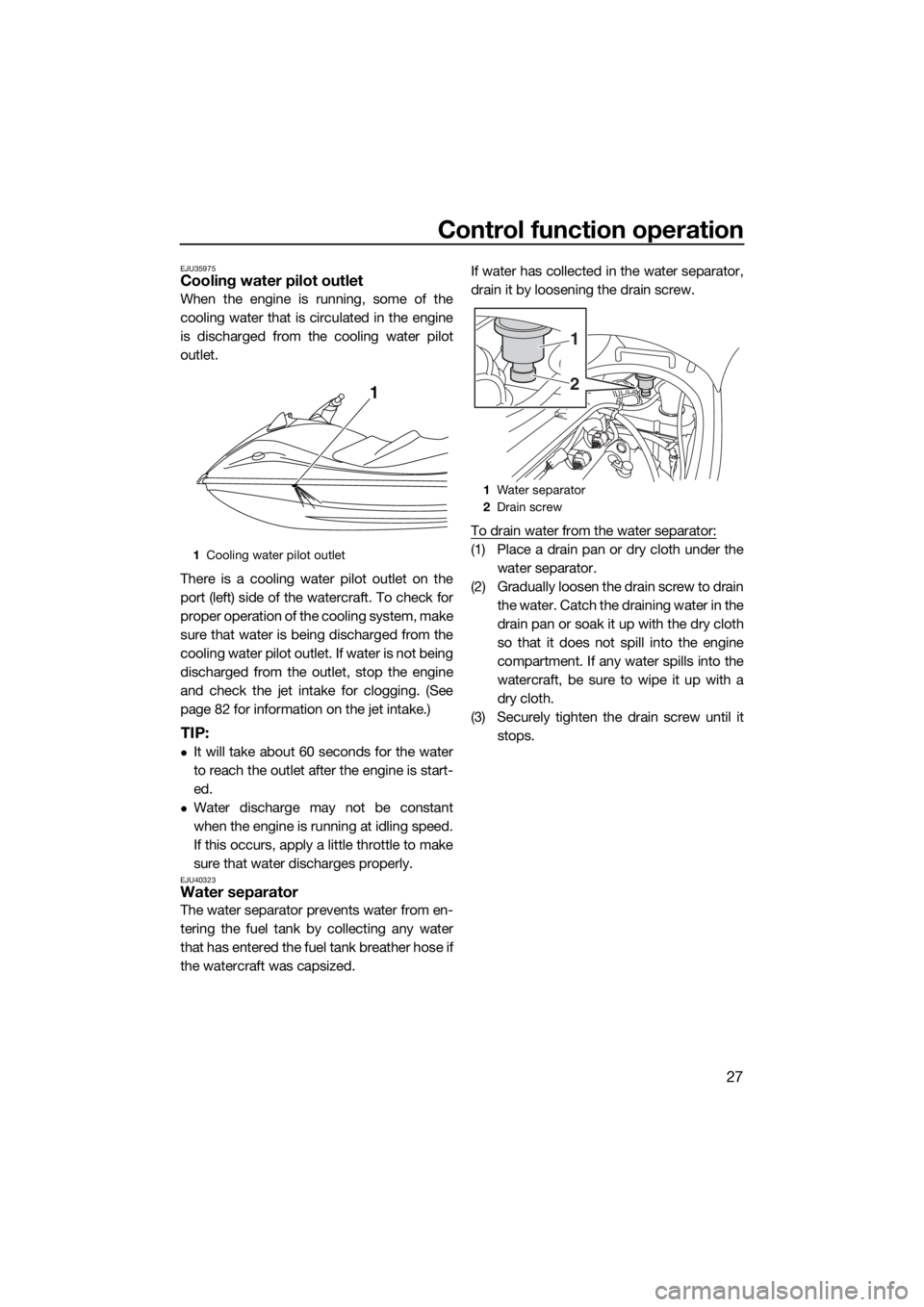
Control function operation
27
EJU35975Cooling water pilot outlet
When the engine is running, some of the
cooling water that is circulated in the engine
is discharged from the cooling water pilot
outlet.
There is a cooling water pilot outlet on the
port (left) side of the watercraft. To check for
proper operation of the cooling system, make
sure that water is being discharged from the
cooling water pilot outlet. If water is not being
discharged from the outlet, stop the engine
and check the jet intake for clogging. (See
page 82 for information on the jet intake.)
TIP:
It will take about 60 seconds for the water
to reach the outlet after the engine is start-
ed.
Water discharge may not be constant
when the engine is running at idling speed.
If this occurs, apply a little throttle to make
sure that water discharges properly.
EJU40323Water separator
The water separator prevents water from en-
tering the fuel tank by collecting any water
that has entered the fuel tank breather hose if
the watercraft was capsized.If water has collected in the water separator,
drain it by loosening the drain screw.
To drain water from the water separator:
(1) Place a drain pan or dry cloth under the
water separator.
(2) Gradually loosen the drain screw to drain
the water. Catch the draining water in the
drain pan or soak it up with the dry cloth
so that it does not spill into the engine
compartment. If any water spills into the
watercraft, be sure to wipe it up with a
dry cloth.
(3) Securely tighten the drain screw until it
stops.1Cooling water pilot outlet
1
1Water separator
2Drain screw
1
2
UF2P72E0.book Page 27 Tuesday, August 26, 2014 10:08 AM
Page 34 of 94
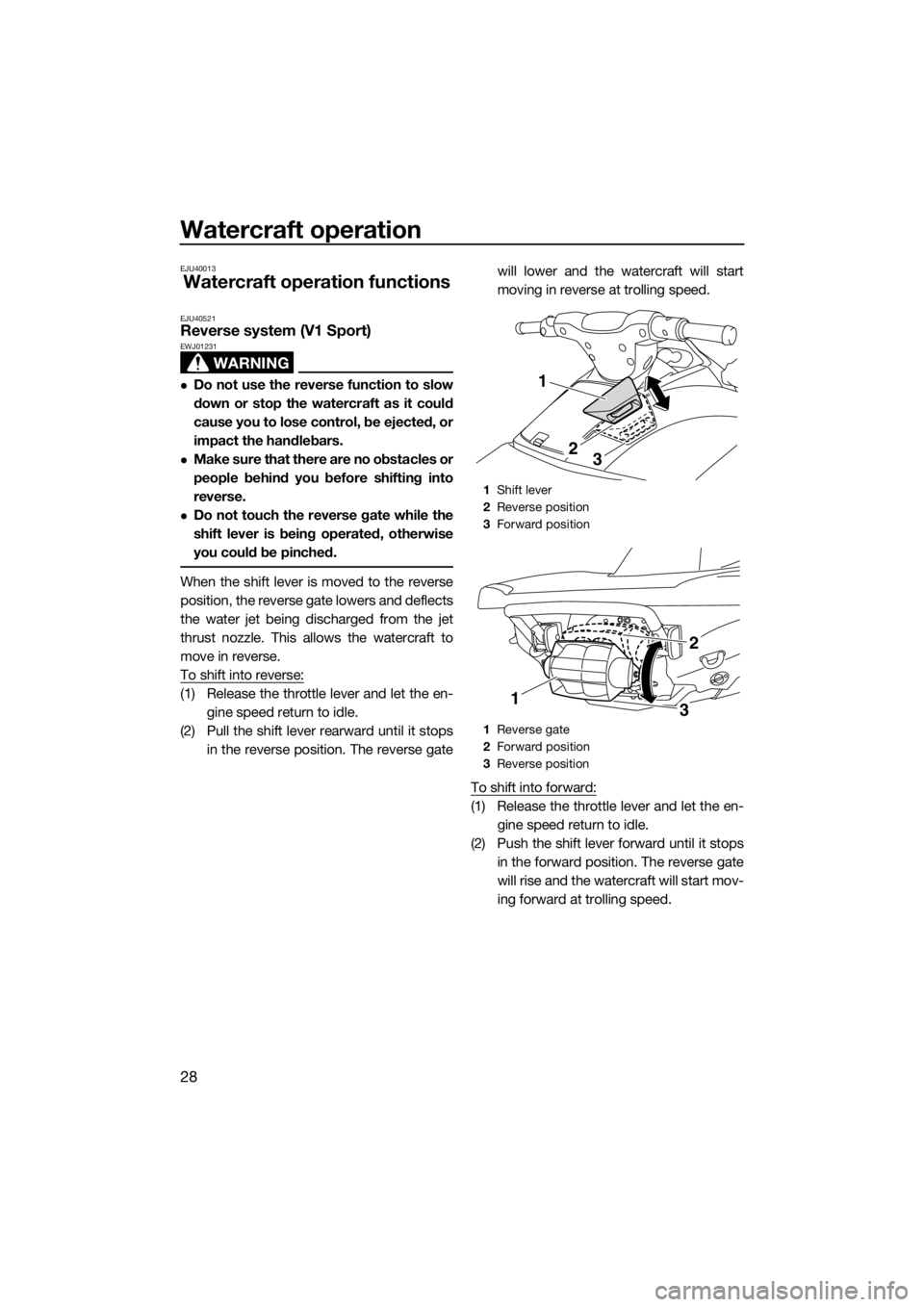
Watercraft operation
28
EJU40013
Watercraft operation functions
EJU40521Reverse system (V1 Sport)
WARNING
EWJ01231
Do not use the reverse function to slow
down or stop the watercraft as it could
cause you to lose control, be ejected, or
impact the handlebars.
Make sure that there are no obstacles or
people behind you before shifting into
reverse.
Do not touch the reverse gate while the
shift lever is being operated, otherwise
you could be pinched.
When the shift lever is moved to the reverse
position, the reverse gate lowers and deflects
the water jet being discharged from the jet
thrust nozzle. This allows the watercraft to
move in reverse.
To shift into reverse:
(1) Release the throttle lever and let the en-
gine speed return to idle.
(2) Pull the shift lever rearward until it stops
in the reverse position. The reverse gatewill lower and the watercraft will start
moving in reverse at trolling speed.
To shift into forward:
(1) Release the throttle lever and let the en-
gine speed return to idle.
(2) Push the shift lever forward until it stops
in the forward position. The reverse gate
will rise and the watercraft will start mov-
ing forward at trolling speed.
1Shift lever
2Reverse position
3Forward position
1Reverse gate
2Forward position
3Reverse position
1
23
13
2
UF2P72E0.book Page 28 Tuesday, August 26, 2014 10:08 AM
Page 35 of 94
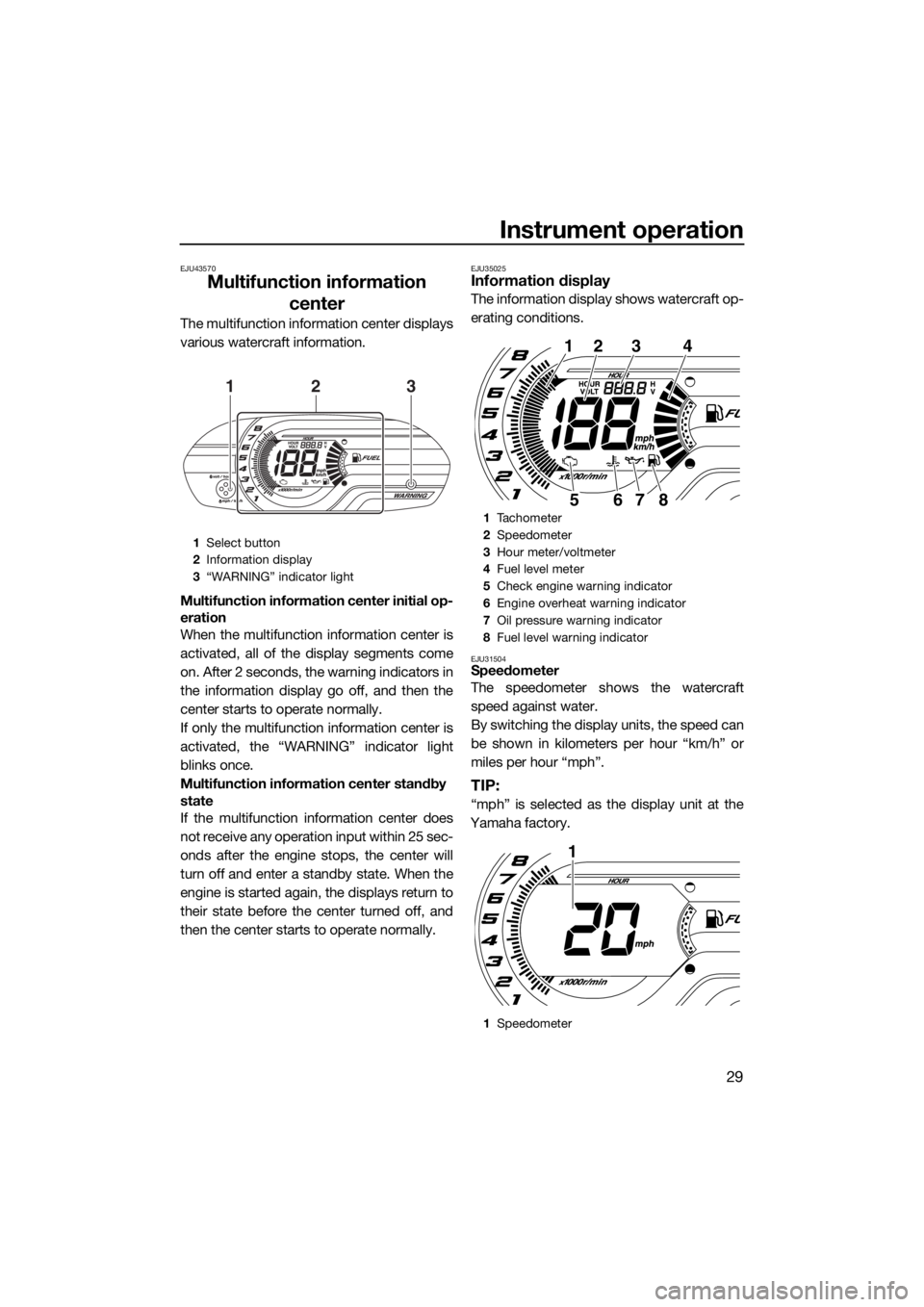
Instrument operation
29
EJU43570
Multifunction information
center
The multifunction information center displays
various watercraft information.
Multifunction information center initial op-
eration
When the multifunction information center is
activated, all of the display segments come
on. After 2 seconds, the warning indicators in
the information display go off, and then the
center starts to operate normally.
If only the multifunction information center is
activated, the “WARNING” indicator light
blinks once.
Multifunction information center standby
state
If the multifunction information center does
not receive any operation input within 25 sec-
onds after the engine stops, the center will
turn off and enter a standby state. When the
engine is started again, the displays return to
their state before the center turned off, and
then the center starts to operate normally.
EJU35025Information display
The information display shows watercraft op-
erating conditions.
EJU31504Speedometer
The speedometer shows the watercraft
speed against water.
By switching the display units, the speed can
be shown in kilometers per hour “km/h” or
miles per hour “mph”.
TIP:
“mph” is selected as the display unit at the
Yamaha factory.
1Select button
2Information display
3“WARNING” indicator light
123
1Tachometer
2Speedometer
3Hour meter/voltmeter
4Fuel level meter
5Check engine warning indicator
6Engine overheat warning indicator
7Oil pressure warning indicator
8Fuel level warning indicator
1Speedometer
1234
8765
1
UF2P72E0.book Page 29 Tuesday, August 26, 2014 10:08 AM
Page 48 of 94
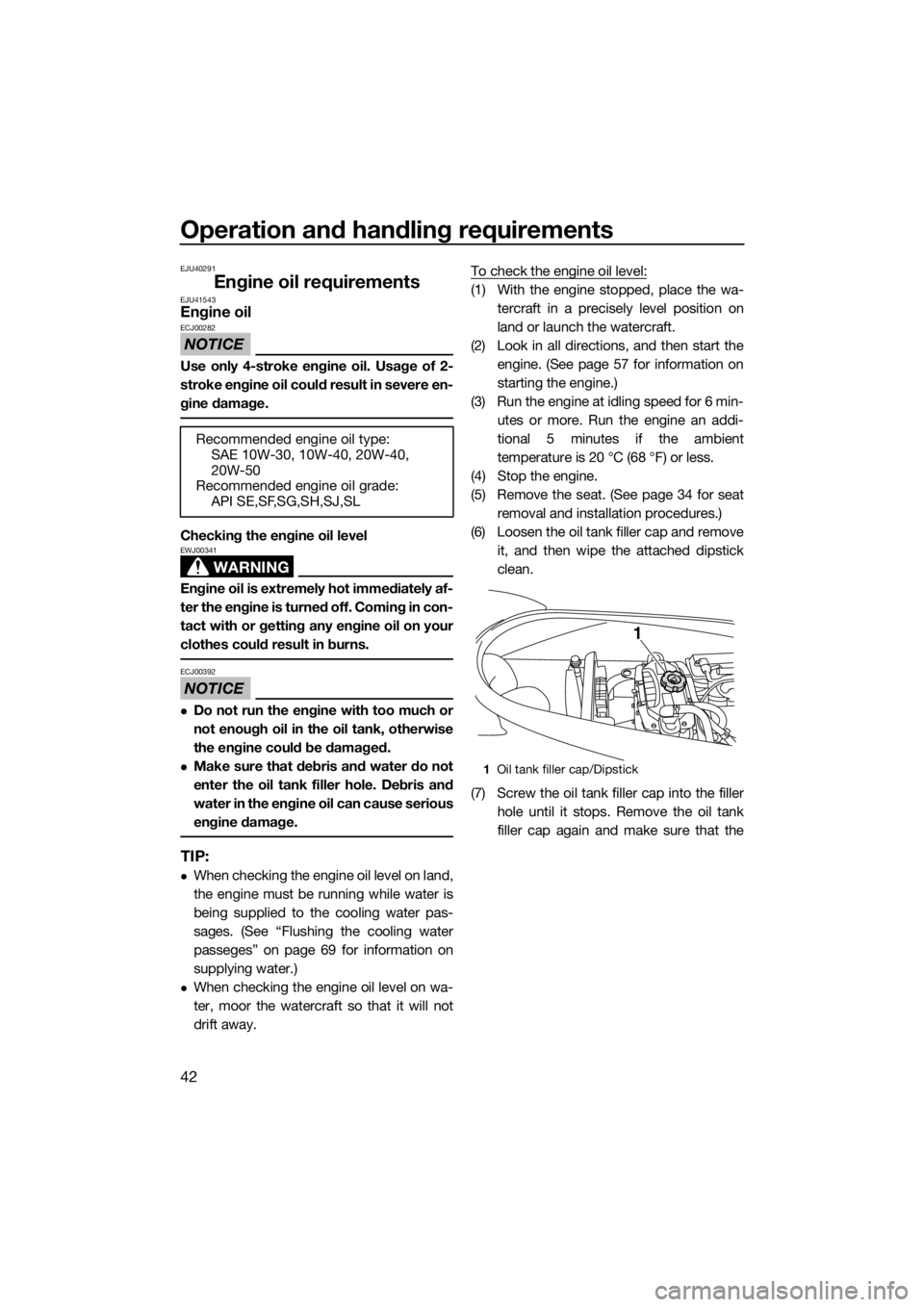
Operation and handling requirements
42
EJU40291
Engine oil requirementsEJU41543Engine oil
NOTICE
ECJ00282
Use only 4-stroke engine oil. Usage of 2-
stroke engine oil could result in severe en-
gine damage.
Checking the engine oil level
WARNING
EWJ00341
Engine oil is extremely hot immediately af-
ter the engine is turned off. Coming in con-
tact with or getting any engine oil on your
clothes could result in burns.
NOTICE
ECJ00392
Do not run the engine with too much or
not enough oil in the oil tank, otherwise
the engine could be damaged.
Make sure that debris and water do not
enter the oil tank filler hole. Debris and
water in the engine oil can cause serious
engine damage.
TIP:
When checking the engine oil level on land,
the engine must be running while water is
being supplied to the cooling water pas-
sages. (See “Flushing the cooling water
passeges” on page 69 for information on
supplying water.)
When checking the engine oil level on wa-
ter, moor the watercraft so that it will not
drift away.To check the engine oil level:
(1) With the engine stopped, place the wa-
tercraft in a precisely level position on
land or launch the watercraft.
(2) Look in all directions, and then start the
engine. (See page 57 for information on
starting the engine.)
(3) Run the engine at idling speed for 6 min-
utes or more. Run the engine an addi-
tional 5 minutes if the ambient
temperature is 20 °C (68 °F) or less.
(4) Stop the engine.
(5) Remove the seat. (See page 34 for seat
removal and installation procedures.)
(6) Loosen the oil tank filler cap and remove
it, and then wipe the attached dipstick
clean.
(7) Screw the oil tank filler cap into the filler
hole until it stops. Remove the oil tank
filler cap again and make sure that the Recommended engine oil type:
SAE 10W-30, 10W-40, 20W-40,
20W-50
Recommended engine oil grade:
API SE,SF,SG,SH,SJ,SL
1Oil tank filler cap/Dipstick
1
UF2P72E0.book Page 42 Tuesday, August 26, 2014 10:08 AM
Page 50 of 94
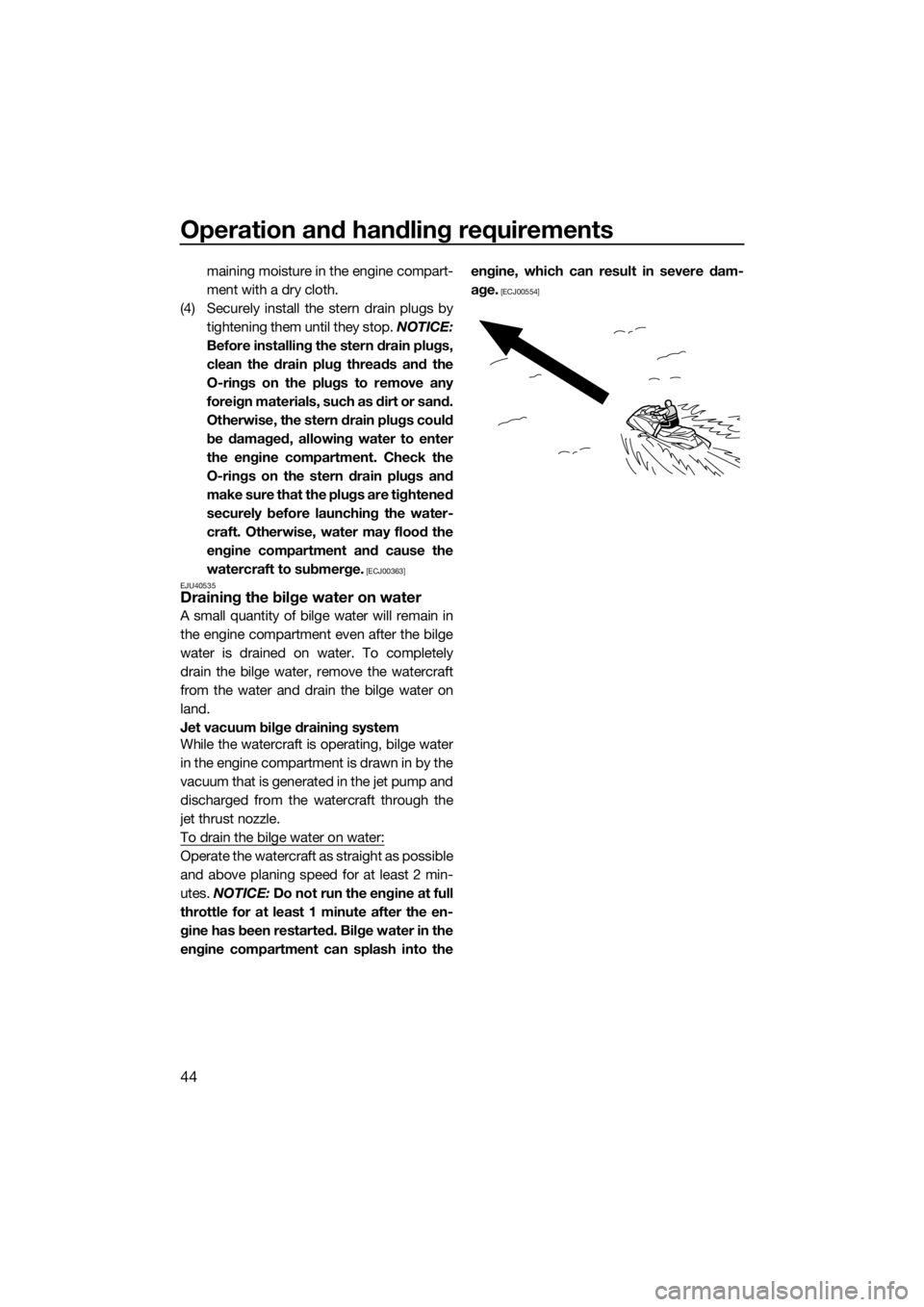
Operation and handling requirements
44
maining moisture in the engine compart-
ment with a dry cloth.
(4) Securely install the stern drain plugs by
tightening them until they stop. NOTICE:
Before installing the stern drain plugs,
clean the drain plug threads and the
O-rings on the plugs to remove any
foreign materials, such as dirt or sand.
Otherwise, the stern drain plugs could
be damaged, allowing water to enter
the engine compartment. Check the
O-rings on the stern drain plugs and
make sure that the plugs are tightened
securely before launching the water-
craft. Otherwise, water may flood the
engine compartment and cause the
watercraft to submerge.
[ECJ00363]
EJU40535
Draining the bilge water on water
A small quantity of bilge water will remain in
the engine compartment even after the bilge
water is drained on water. To completely
drain the bilge water, remove the watercraft
from the water and drain the bilge water on
land.
Jet vacuum bilge draining system
While the watercraft is operating, bilge water
in the engine compartment is drawn in by the
vacuum that is generated in the jet pump and
discharged from the watercraft through the
jet thrust nozzle.
To drain the bilge water on water:
Operate the watercraft as straight as possible
and above planing speed for at least 2 min-
utes. NOTICE: Do not run the engine at full
throttle for at least 1 minute after the en-
gine has been restarted. Bilge water in the
engine compartment can splash into theengine, which can result in severe dam-
age.
[ECJ00554]
UF2P72E0.book Page 44 Tuesday, August 26, 2014 10:08 AM
Page 53 of 94

Pre-operation checks
47
EJU31982
WARNING
EWJ00412
Failure to inspect or maintain the watercraft properly increases the possibility of an ac-
cident or damage to the watercraft. Do not operate the watercraft if you find any prob-
lem. If a problem cannot be corrected by the procedures provided in this manual, have
the watercraft inspected by a Yamaha dealer.
EJU41234Pre-operation checklist
Before using this watercraft, be sure to perform the checks in the following checklist.
ITEM ROUTINE PAGE
PRE-LAUNCH CHECKS
Engine compartmentVentilate the engine compartment.
Check inside the engine compartment for damage.49
Fuel systemCheck the fuel system for leakage.
Check the fuel level in the fuel tank.49
Water separatorCheck the water separator for water. 49
Engine unitCheck the exterior of the engine unit for damage. 49
Engine oil levelCheck the engine oil level. 49
Bilge waterCheck the engine compartment for bilge water. 50
BatteryCheck the battery connections and electrolyte level. 50
Steering systemCheck the steering system for proper operation. 50
Reverse system (V1 Sport)Check the reverse system for proper operation. 51
Throttle leverCheck the throttle lever for proper operation.
Check the throttle lever free play.52
Engine shut-off cord (lan-
yard)Check the engine shut-off cord (lanyard) for dam-
age.52
SwitchesCheck the start switch, engine stop switch, and en-
gine shut-off switch for proper operation.53
Storage compartmentsCheck the storage compartments for damage and
water.53
Fire extinguisher holder,
cover, and bandCheck the fire extinguisher holder, cover, and band
for damage.53
Fire extinguisherCheck the condition of the fire extinguisher. 53
Safety equipmentCheck that safety equipment meeting the applica-
ble regulations is on board.54
Hull and deckCheck the hull and deck for damage. 54
Jet intakeCheck the jet intake for damage and clogging. 54
Stern drain plugsCheck the stern drain plugs for damage and foreign
material and check that they are securely installed.54
HoodCheck that the hood is securely closed. 54
SeatCheck that the seat is securely installed. 34
UF2P72E0.book Page 47 Tuesday, August 26, 2014 10:08 AM